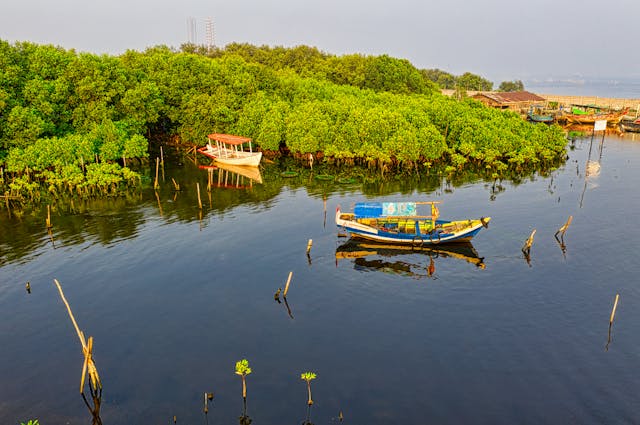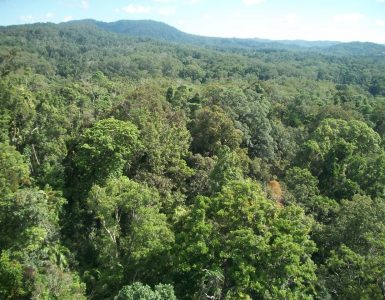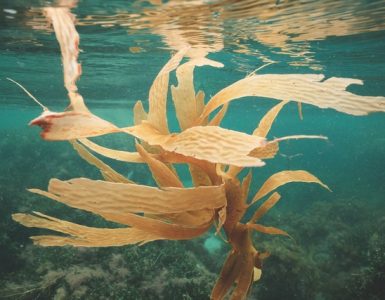India is home to the largest mangrove forest in the world, the Sundarbans mangrove forest, located in the delta region of the Ganges, Brahmaputra, and Meghna rivers in West Bengal. It is the largest continuous mangrove forest in the world, covering about 10,000 square kilometers and stretching into Bangladesh as well.
The Sundarbans is among India’s earliest UNESCO World Heritage sites, famous for its rich biodiversity, including the Bengal tiger, saltwater crocodiles, and numerous species of birds, fish, and reptiles.
The mangroves play a crucial role in protecting coastal areas from erosion and storm surges, acting as a natural barrier against rising sea levels.
Unfortunately, mangroves are increasingly threatened by deforestation, urbanization, infrastructure development, pollution, and severe storms.
A study released on the International Day for Biodiversity 2024, ” 50% of the mangrove ecosystems assessed are at risk of collapse (classed as either Vulnerable, Endangered, or Critically Endangered*).”
The research is the first global mangrove assessment, led by the International Union for Conservation of Nature and Natural Resources (IUCN), has put “nearly 20% (19.6%) of the assessed mangroves are at high risk, classed as either Endangered or Critically Endangered, reflecting these areas are at severe risk of collapse.”
In India, apart from West Bengal, mangrove forests are found along the coast of eight other states and four Union Territories (UTs). Many of these ecological zones face risks due to human-caused factors like coastal development and infrastructure projects, such as ports, resorts, and housing.
Forest Survey of India (FSI), an organization mandated with forest survey under the Ministry of Environment, Forest and Climate Change (MoEFCC), publishes “India State of Forest Report” (ISFR) biennially. As per the recent ISFR 2023, India’s total mangrove cover is 4,991.68 sq. km, 0.15 % of the country’s total geographical area.
Interestingly, in 2023, the report has assessed a net increase of 363.68 Sq. km (7.86%) in the mangrove forest in India as compared to 2013, and a net increase of 509.68 Sq. km (11.4%) between 2001 and 2023.
Thanks to the concentrated efforts of the government and authorities, who have implemented several regulatory and promotional measures to protect and enhance mangrove forests in India across coastal States and Union Territories.
Coastal Zone Regulation Notification of 2019 (CRZ) under the Environment (Protection) Act, 1986 classifies mangroves as Ecologically Sensitive Areas (ESAs); therefore, only limited activities are allowed in these areas. A 50-meter buffer zone along mangroves is also specified as CRZ-IA if the mangrove cover is greater than 1,000 square meters.
Activities permitted in the mangrove buffer are limited to laying pipelines, transmission lines, conveyance systems or mechanisms, and road construction on stilts, among other things required for public utilities.
In such instances, if any mangroves are likely to be affected during the developmental process, three times the number of mangroves lost must be replanted as per the provisions of the CRZ regulation.
The promotional measure includes the ‘Mangrove Initiative for Shoreline Habitats & Tangible Incomes (MISHTI) programme, launched by the Government of India in 2024 to comprehensively explore the possible area for the development of Mangroves covering approximately 540 sq. km spread across the coastline of India.
The objective is to conserve and restore mangrove forests in India and organise awareness campaigns to educate coastal communities about their importance and role in protecting the environment.

MISHTI implementation is carried out by coastal State and UT governments, with financial support through convergence and gap funding from the National Compensatory Afforestation Fund Management and Planning Authority (CAMPA).
For the financial year 2024-25, Rs 17.96 crore has been allocated from CAMPA to Andhra Pradesh, Gujarat, Kerala, Odisha, West Bengal, and the Union Territory of Puducherry for the treatment of 3836 ha of degraded Mangroves and restoration efforts.
Furthermore, ‘Conservation and Management of Mangroves and Coral Reefs’ under National Coastal Mission scheme of the Ministry of Environment, Forest & Climate Change provides financial assistance to coastal States and Union Territories (UTs) for the conservation and management of 38 identified mangrove sites and four coral reef sites across nine coastal states and four UTs.
Under this scheme, State governments submit proposals to seek financial support, which is provided in a 60:40 cost-sharing ratio between the Central and State Governments. An amount of Rs. 8.58 Cr has been released as Central assistance to 7 Coastal States during 2021-23 under the scheme for conservation and management of Mangroves.
In addition, MoEFCC, with the support of three Coastal States (Andhra Pradesh, Maharashtra and Odisha), is implementing the Green Climate Fund-assisted Enhancing Coastal Resilience of Indian Coastal Community (GCF-ECRICC) project since 2019.
The project has a target for restoration and conservation of 10,575 ha of mangroves in the states of Andhra Pradesh, Maharashtra and Odisha, and approximately 3114.29 ha has been achieved during 2019-2024.
While the government is making efforts to protect mangrove forests in India, the work of several individuals and organizations is also noteworthy.
Kolkata-based Sundarban Foundation, Tamil Nadu-based Mangrove Foundation of India, and Mumbai Mangrove Conservation Unit, among many others, are involved in mangrove conservation and protection.
In Kochi, Murukesan is known as the ‘Mangrove Man’ because of his relentless efforts to protect mangroves that grow along the Kerala coast. In Odisha, Bijay Kumar Kabi has been working towards mangrove restoration since 2008.
Wrapping Up
Mangroves are vital ecosystems that provide a range of ecological, social, and economic benefits, such as coastal protection, biodiversity support, and carbon sequestration.
Given the threats these ecosystems face, public-private partnerships can be a highly effective strategy to combine the resources, expertise, and influence of the government, individuals and private organizations in conservation efforts.
Mangrove forests in India are not just ecologically important but also provide critical services that support the livelihoods along the coastline. By investing in conservation and restoration programs, India can protect its valuable mangrove ecosystems, which play a crucial role in the health and resilience of coastal regions.





Add comment